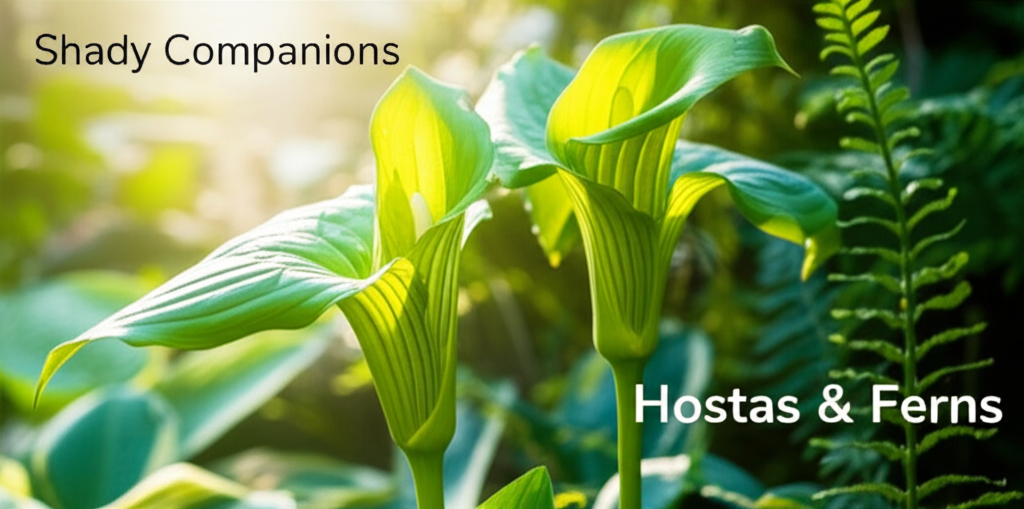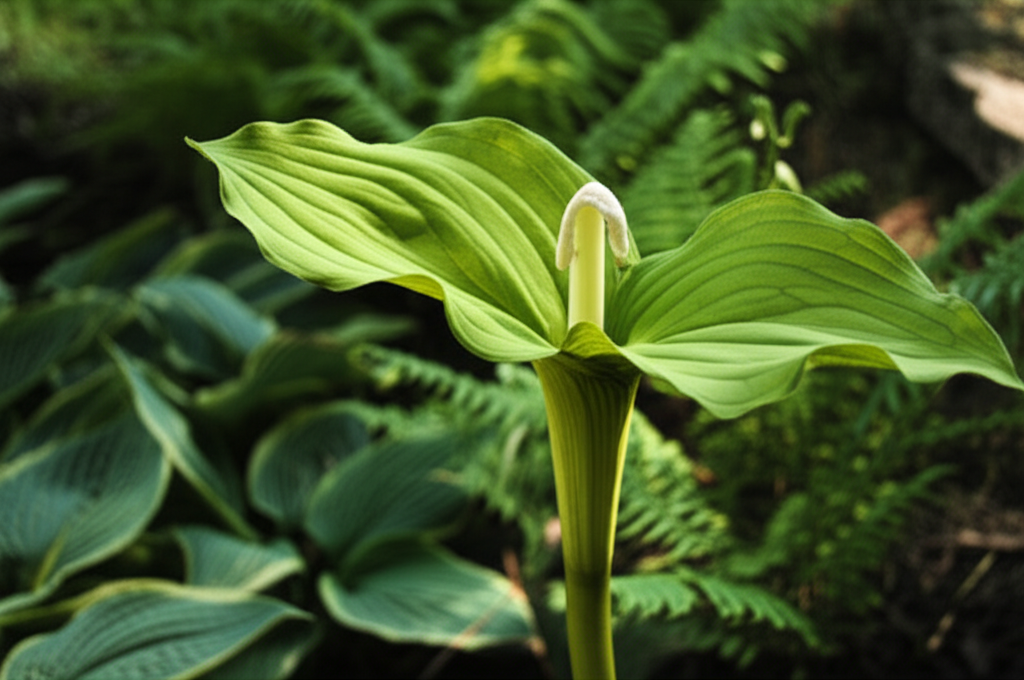Introduction to Jack-in-the-Pulpit
The Jack-in-the-Pulpit (Arisaema triphyllum) is a captivating native woodland perennial that adds a unique charm to any shady garden. Its distinctive spathe and spadix, resembling a pulpit with a preacher inside, make it a conversation starter. Beyond its aesthetic appeal, Jack-in-the-Pulpit thrives in similar conditions to many popular shade-loving plants, making it an ideal candidate for companion planting. This article explores the benefits and best practices of pairing Jack-in-the-Pulpit with hostas and ferns, two staples of the shade garden.
Understanding Jack-in-the-Pulpit’s Needs
To successfully companion plant, it’s crucial to understand the specific requirements of each plant. Jack-in-the-Pulpit, a member of the Araceae family, is a herbaceous perennial that typically grows in moist, well-drained, humus-rich soil. It prefers dappled shade to full shade and can be found naturally in woodlands, swamps, and along stream banks.
- Light: Partial to full shade. Direct sunlight can scorch its leaves.
- Soil: Moist, well-drained, acidic to neutral pH, rich in organic matter.
- Water: Consistent moisture is essential, especially during its active growing season.
- Temperature: Hardy in USDA zones 4-9.
- Growth Habit: It emerges in spring, produces its unique flower in late spring to early summer, and then dies back to the ground in late summer, leaving behind bright red berries. It is a deciduous perennial, meaning it loses its leaves seasonally.
Why Companion Plant with Hostas and Ferns?

Companion planting is a horticultural technique where plants are grown in close proximity to benefit each other. These benefits can include pest deterrence, nutrient sharing, improved soil structure, and enhanced aesthetic appeal. Hostas and ferns are natural companions for Jack-in-the-Pulpit due to their shared ecological preferences.
Shared Habitat and Growing Conditions
Both hostas and ferns are quintessential shade garden plants. They typically thrive in the same environments that Jack-in-the-Pulpit calls home:
- Understory of Trees: All three plants naturally grow in the understory of deciduous forests, benefiting from the shade provided by a tree canopy.
- Moist, Humus-Rich Soil: These plants all appreciate soil that is consistently moist and amended with organic matter, which mimics the forest floor.
- Protection from Harsh Elements: The dappled shade provided by trees offers protection from scorching sun and drying winds, creating an ideal microclimate for all three.
Aesthetic Harmony
The visual appeal of planting these species together is undeniable.
- Texture Contrast: The broad, often ribbed leaves of hostas and the delicate, feathery fronds of ferns provide a beautiful textural contrast to the unique, umbrella-like leaves of the Jack-in-the-Pulpit.
- Color Palette: While hostas offer a wide range of green, blue-green, and variegated foliage, ferns typically display various shades of green. Jack-in-the-Pulpit’s green leaves, followed by its striking hooded flower and then vibrant red berries, add further visual interest throughout the seasons.
- Layering and Depth: Planting these species at different heights and growth habits creates a layered effect, adding depth and complexity to the garden design.
Ecological Benefits
Beyond aesthetics, companion planting can offer ecological advantages.
- Groundcover and Soil Protection: Hostas and ferns act as excellent groundcovers, helping to suppress weeds and retain soil moisture, which benefits the Jack-in-the-Pulpit.
- Attracting Beneficial Wildlife: The berries of the Jack-in-the-Pulpit attract birds, while the foliage of hostas and ferns can provide habitat for beneficial insects.
- Nutrient Cycling: As these plants decompose, they contribute to the rich organic matter that all three species depend on.
Key Facts and Comparison: Jack-in-the-Pulpit, Hostas, and Ferns
Here’s a comparative look at these three popular shade garden residents:
| Feature | Jack-in-the-Pulpit | Hostas | Ferns |
|---|---|---|---|
| Botanical Name | Arisaema triphyllum | Hosta spp. | Various families (e.g., Polypodiaceae, Dryopteridaceae) |
| Sunlight Needs | Partial to full shade | Partial to full shade | Partial to full shade |
| Soil Preference | Moist, well-drained, humus-rich | Moist, well-drained, humus-rich | Moist, well-drained, humus-rich |
| Water Needs | Consistent moisture | Consistent moisture | Consistent moisture |
| Bloom Time | Late spring to early summer | Mid to late summer (depending on variety) | No prominent blooms (reproduces via spores) |
| Foliage Interest | Unique hooded flower, trifoliate leaves, red berries | Wide variety of leaf colors, textures, and sizes | Delicate, feathery fronds in various shades of green |
| Mature Size | 1-3 feet tall | Varies greatly by cultivar (from miniature to very large) | Varies greatly by species (from groundcover to several feet tall) |
| Hardiness Zones | 4-9 | 3-9 | Varies by species (many are hardy to zone 3 or 4) |
Planting Strategies for a Harmonious Shade Garden
When planting Jack-in-the-Pulpit with hostas and ferns, consider their mature sizes, growth habits, and seasonal interest to create a well-balanced and visually appealing display.
Site Selection and Preparation
Choose a location that receives at least 4-6 hours of shade per day. The soil should be amended generously with compost or other organic matter to improve drainage and fertility. A slightly acidic to neutral pH (6.0-7.0) is ideal for all three.
Planting Arrangement
- Behind and Among Hostas: Plant Jack-in-the-Pulpit behind larger hostas to allow its unique bloom to peek through, or intersperse smaller varieties of Jack-in-the-Pulpit amongst the base of hostas.
- Interplanting with Ferns: The delicate fronds of ferns provide a beautiful backdrop for the more architectural form of the Jack-in-the-Pulpit. Consider planting them at the same level or slightly behind.
- Grouping for Impact: Plant several Jack-in-the-Pulpits together for a more dramatic effect, surrounded by a tapestry of hostas and ferns.
- Considering Seasonal Changes: Remember that Jack-in-the-Pulpit dies back after fruiting. Place it in areas where its disappearing act won’t leave a large gap, or interplant with other plants that will fill in, such as groundcover hostas or shade-tolerant groundcovers.
Watering and Mulching
Maintain consistent moisture, especially during dry periods, by watering deeply and regularly. A layer of organic mulch (wood chips, shredded bark, or compost) will help retain soil moisture, suppress weeds, and regulate soil temperature, benefiting all three plants.
Steps, Pros, and Cons of Companion Planting
Here’s a breakdown of the process, along with the advantages and disadvantages of this particular companion planting combination:
| Aspect | Details |
|---|---|
| Steps for Planting |
|
| Pros |
|
| Cons |
|
Troubleshooting Common Issues
Even with ideal companion planting, challenges can arise. Understanding potential problems and their solutions will ensure a thriving shade garden.
Slugs and Snails
These common garden pests are particularly fond of hostas and can also damage young Jack-in-the-Pulpit leaves and fern fronds.
- Prevention: Maintain good air circulation, remove hiding places (like fallen leaves), and water in the morning.
- Control: Handpick slugs and snails at dawn or dusk. Use organic slug baits (iron phosphate), or set up beer traps. Copper tape around garden beds can also be effective.
Dormancy of Jack-in-the-Pulpit
As mentioned, Jack-in-the-Pulpit disappears in late summer after its berries have ripened.
- Mitigation: Plant shorter, later-blooming hostas or groundcover ferns in front of or around the Jack-in-the-Pulpit to fill the visual void. Consider plants that provide late-season interest, such as astilbe or heuchera, though ensure they have similar moisture needs.
Inconsistent Moisture
While all three prefer moist soil, too much or too little can cause problems.
- Too Little Water: Wilting leaves, stunted growth, and increased susceptibility to pests. Ensure regular watering, especially during dry spells.
- Too Much Water (Poor Drainage): Root rot, yellowing leaves. Ensure your soil is well-drained. If your garden tends to stay waterlogged, consider raised beds or amending with more grit.
Light Levels
While they all prefer shade, the degree of shade can matter.
- Too Much Sun: Scorched leaves on Jack-in-the-Pulpit and ferns, bleached foliage on hostas. Ensure the location provides deep shade, especially during the hottest part of the day.
- Too Little Sun: Reduced vigor, less flowering on hostas, pale foliage. While they tolerate shade, some varieties may need brighter dappled light to perform optimally. Observe your plants and adjust placement if needed.
Enhancing the Jack-in-the-Pulpit, Hosta, and Fern Garden
Beyond the core companions, consider other plants that complement this woodland aesthetic.
Groundcovers
- Wild Ginger (Asarum canadense): Spreading groundcover with heart-shaped leaves, thriving in similar conditions.
- Creeping Jenny (Lysimachia nummularia): Adds a bright, lime-green contrast, though it can be vigorous.
- Moss: In consistently damp, shady areas, moss can create a lush, naturalistic carpet.
Perennials for Added Interest
- Astilbe: Offers feathery plumes of flowers in various colors and blooms in mid to late summer, providing color after the Jack-in-the-Pulpit has gone dormant.
- Coral Bells (Heuchera): Known for their stunning foliage in shades of purple, bronze, amber, and lime green, providing year-round color and texture.
- Bleeding Hearts (Dicentra spectabilis): Delicate, heart-shaped flowers in spring add charm before the Jack-in-the-Pulpit fully matures.
- Foamflower (Tiarella cordifolia): Delicate, airy white flower spikes in spring and attractive, often marked foliage.
Conclusion
Companion planting Jack-in-the-Pulpit with hostas and ferns is a natural and highly rewarding horticultural practice. These three plants share a love for moist, shady environments, creating a harmonious and low-maintenance garden tapestry. By understanding their individual needs and planting them strategically, you can cultivate a visually captivating and ecologically beneficial woodland oasis. The unique appeal of the Jack-in-the-Pulpit, combined with the reliable beauty of hostas and the delicate charm of ferns, ensures a shade garden that delights season after season.


